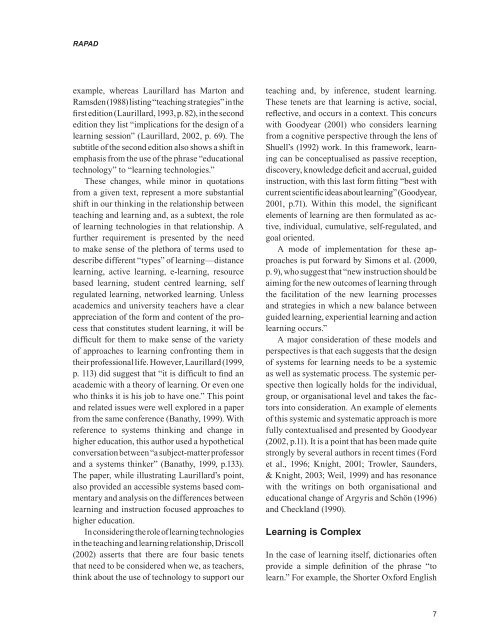Advances in E-learning-Experiences and Methodologies
Create successful ePaper yourself
Turn your PDF publications into a flip-book with our unique Google optimized e-Paper software.
RAPAD<br />
example, whereas Laurillard has Marton <strong>and</strong><br />
Ramsden (1988) list<strong>in</strong>g “teach<strong>in</strong>g strategies” <strong>in</strong> the<br />
first edition (Laurillard, 1993, p. 82), <strong>in</strong> the second<br />
edition they list “implications for the design of a<br />
learn<strong>in</strong>g session” (Laurillard, 2002, p. 69). The<br />
subtitle of the second edition also shows a shift <strong>in</strong><br />
emphasis from the use of the phrase “educational<br />
technology” to “learn<strong>in</strong>g technologies.”<br />
These changes, while m<strong>in</strong>or <strong>in</strong> quotations<br />
from a given text, represent a more substantial<br />
shift <strong>in</strong> our th<strong>in</strong>k<strong>in</strong>g <strong>in</strong> the relationship between<br />
teach<strong>in</strong>g <strong>and</strong> learn<strong>in</strong>g <strong>and</strong>, as a subtext, the role<br />
of learn<strong>in</strong>g technologies <strong>in</strong> that relationship. A<br />
further requirement is presented by the need<br />
to make sense of the plethora of terms used to<br />
describe different “types” of learn<strong>in</strong>g—distance<br />
learn<strong>in</strong>g, active learn<strong>in</strong>g, e-learn<strong>in</strong>g, resource<br />
based learn<strong>in</strong>g, student centred learn<strong>in</strong>g, self<br />
regulated learn<strong>in</strong>g, networked learn<strong>in</strong>g. Unless<br />
academics <strong>and</strong> university teachers have a clear<br />
appreciation of the form <strong>and</strong> content of the process<br />
that constitutes student learn<strong>in</strong>g, it will be<br />
difficult for them to make sense of the variety<br />
of approaches to learn<strong>in</strong>g confront<strong>in</strong>g them <strong>in</strong><br />
their professional life. However, Laurillard (1999,<br />
p. 113) did suggest that “it is difficult to f<strong>in</strong>d an<br />
academic with a theory of learn<strong>in</strong>g. Or even one<br />
who th<strong>in</strong>ks it is his job to have one.” This po<strong>in</strong>t<br />
<strong>and</strong> related issues were well explored <strong>in</strong> a paper<br />
from the same conference (Banathy, 1999). With<br />
reference to systems th<strong>in</strong>k<strong>in</strong>g <strong>and</strong> change <strong>in</strong><br />
higher education, this author used a hypothetical<br />
conversation between “a subject-matter professor<br />
<strong>and</strong> a systems th<strong>in</strong>ker” (Banathy, 1999, p.133).<br />
The paper, while illustrat<strong>in</strong>g Laurillard’s po<strong>in</strong>t,<br />
also provided an accessible systems based commentary<br />
<strong>and</strong> analysis on the differences between<br />
learn<strong>in</strong>g <strong>and</strong> <strong>in</strong>struction focused approaches to<br />
higher education.<br />
In consider<strong>in</strong>g the role of learn<strong>in</strong>g technologies<br />
<strong>in</strong> the teach<strong>in</strong>g <strong>and</strong> learn<strong>in</strong>g relationship, Driscoll<br />
(2002) asserts that there are four basic tenets<br />
that need to be considered when we, as teachers,<br />
th<strong>in</strong>k about the use of technology to support our<br />
teach<strong>in</strong>g <strong>and</strong>, by <strong>in</strong>ference, student learn<strong>in</strong>g.<br />
These tenets are that learn<strong>in</strong>g is active, social,<br />
reflective, <strong>and</strong> occurs <strong>in</strong> a context. This concurs<br />
with Goodyear (2001) who considers learn<strong>in</strong>g<br />
from a cognitive perspective through the lens of<br />
Shuell’s (1992) work. In this framework, learn<strong>in</strong>g<br />
can be conceptualised as passive reception,<br />
discovery, knowledge deficit <strong>and</strong> accrual, guided<br />
<strong>in</strong>struction, with this last form fitt<strong>in</strong>g “best with<br />
current scientific ideas about learn<strong>in</strong>g” (Goodyear,<br />
2001, p.71). With<strong>in</strong> this model, the significant<br />
elements of learn<strong>in</strong>g are then formulated as active,<br />
<strong>in</strong>dividual, cumulative, self-regulated, <strong>and</strong><br />
goal oriented.<br />
A mode of implementation for these approaches<br />
is put forward by Simons et al. (2000,<br />
p. 9), who suggest that “new <strong>in</strong>struction should be<br />
aim<strong>in</strong>g for the new outcomes of learn<strong>in</strong>g through<br />
the facilitation of the new learn<strong>in</strong>g processes<br />
<strong>and</strong> strategies <strong>in</strong> which a new balance between<br />
guided learn<strong>in</strong>g, experiential learn<strong>in</strong>g <strong>and</strong> action<br />
learn<strong>in</strong>g occurs.”<br />
A major consideration of these models <strong>and</strong><br />
perspectives is that each suggests that the design<br />
of systems for learn<strong>in</strong>g needs to be a systemic<br />
as well as systematic process. The systemic perspective<br />
then logically holds for the <strong>in</strong>dividual,<br />
group, or organisational level <strong>and</strong> takes the factors<br />
<strong>in</strong>to consideration. An example of elements<br />
of this systemic <strong>and</strong> systematic approach is more<br />
fully contextualised <strong>and</strong> presented by Goodyear<br />
(2002, p.11). It is a po<strong>in</strong>t that has been made quite<br />
strongly by several authors <strong>in</strong> recent times (Ford<br />
et al., 1996; Knight, 2001; Trowler, Saunders,<br />
& Knight, 2003; Weil, 1999) <strong>and</strong> has resonance<br />
with the writ<strong>in</strong>gs on both organisational <strong>and</strong><br />
educational change of Argyris <strong>and</strong> Schön (1996)<br />
<strong>and</strong> Checkl<strong>and</strong> (1990).<br />
Learn<strong>in</strong>g is complex<br />
In the case of learn<strong>in</strong>g itself, dictionaries often<br />
provide a simple def<strong>in</strong>ition of the phrase “to<br />
learn.” For example, the Shorter Oxford English


